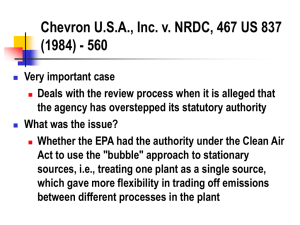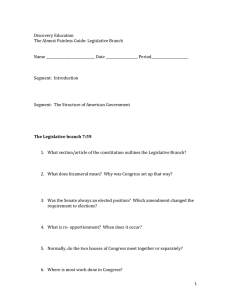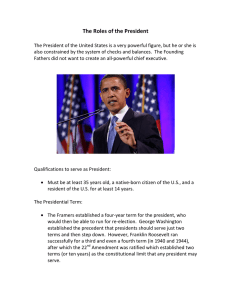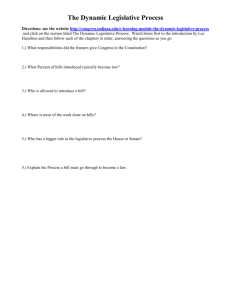Administrative and Regulatory State
advertisement
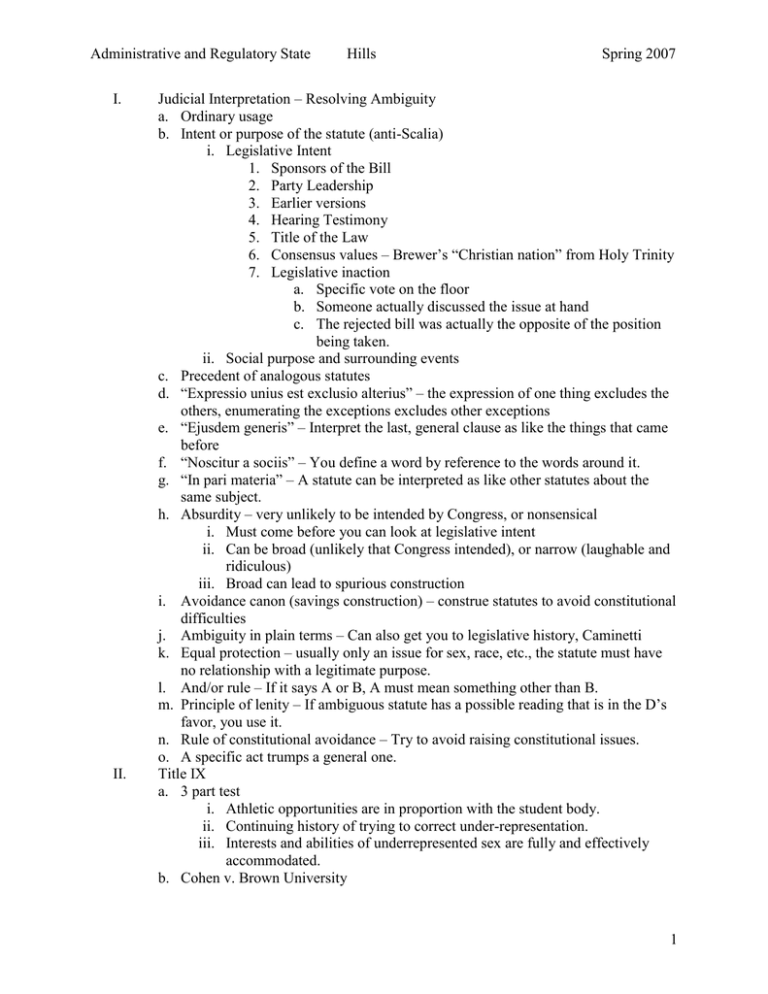
Administrative and Regulatory State I. II. Hills Spring 2007 Judicial Interpretation – Resolving Ambiguity a. Ordinary usage b. Intent or purpose of the statute (anti-Scalia) i. Legislative Intent 1. Sponsors of the Bill 2. Party Leadership 3. Earlier versions 4. Hearing Testimony 5. Title of the Law 6. Consensus values – Brewer’s “Christian nation” from Holy Trinity 7. Legislative inaction a. Specific vote on the floor b. Someone actually discussed the issue at hand c. The rejected bill was actually the opposite of the position being taken. ii. Social purpose and surrounding events c. Precedent of analogous statutes d. “Expressio unius est exclusio alterius” – the expression of one thing excludes the others, enumerating the exceptions excludes other exceptions e. “Ejusdem generis” – Interpret the last, general clause as like the things that came before f. “Noscitur a sociis” – You define a word by reference to the words around it. g. “In pari materia” – A statute can be interpreted as like other statutes about the same subject. h. Absurdity – very unlikely to be intended by Congress, or nonsensical i. Must come before you can look at legislative intent ii. Can be broad (unlikely that Congress intended), or narrow (laughable and ridiculous) iii. Broad can lead to spurious construction i. Avoidance canon (savings construction) – construe statutes to avoid constitutional difficulties j. Ambiguity in plain terms – Can also get you to legislative history, Caminetti k. Equal protection – usually only an issue for sex, race, etc., the statute must have no relationship with a legitimate purpose. l. And/or rule – If it says A or B, A must mean something other than B. m. Principle of lenity – If ambiguous statute has a possible reading that is in the D’s favor, you use it. n. Rule of constitutional avoidance – Try to avoid raising constitutional issues. o. A specific act trumps a general one. Title IX a. 3 part test i. Athletic opportunities are in proportion with the student body. ii. Continuing history of trying to correct under-representation. iii. Interests and abilities of underrepresented sex are fully and effectively accommodated. b. Cohen v. Brown University 1 Administrative and Regulatory State III. Hills Spring 2007 i. You can’t cut teams equally to get around it. ii. c. Cohen II i. Do the 1st and 2nd prongs violate the prohibition in statistical balancing? ii. The 3rd prong makes it ok, but violates preferential treatment. iii. Court says that 3rd not preferential, because the school can accommodate both sexes. d. Kelley v. Board of Trustees i. Plain language of “on the basis of” might be violated by cutting men’s teams. ii. Court dismisses the analogy to Title VII. iii. Hills thinks this is wrong. e. Courts defer to the agency because they have Congressional deference. Interpretation Cases a. Intentionalism/Purposivism i. Rector of Holy Trinity Church v. US 1. Actual language contradicts the court’s decision. 2. “expressio unius” – the exceptions included should be the only exceptions meant 3. The court goes with legislative intent over ordinary usage (Brewer). ii. Spurious Interpretation – Pound 1. Tends to try to reach a predetermined end 2. He thinks it’s ok to look at the merit of the end iii. Public Citizen v. US Dept of Justice 1. The statute seems clear, Brennan disagrees. 2. Brennan thinks this is absurd, would lead to far too broad a result. 3. Kennedy says it’s not absurd, possibly not constitutional. 4. Courts tend to avoid constitutional interpretation. b. Textualism i. Easterbrook – how would it sound to a skilled user of words, Never look at intent. ii. Executive Summary – Take the most plausible way it could be interpreted, you can look at legislative history to pick one of several plausible meanings. iii. Caminetti v. US 1. Use legislative history to choose between possible meanings of “immoral purposes” 2. There is precedent as to “immoral,” and they look at absurdity doctrine. 3. “Ejusdem generis” – Immoral purpose is like prostitution and debauchery, so it’s only sexual stuff. 4. McKenna looks to legislative intent, title of the statute. 5. Day wants to stop at plain meaning. iv. The case for textualism 1. Constitutional legitimacy 2 Administrative and Regulatory State Hills Spring 2007 2. Judicial restraint 3. Reduction of costs of research 4. Ex ante incentives – interest groups influencing laws after legislation v. Green v. Bock Laundry 1. Uses absurdity canon, legislative history to preserve the text, even though textualist 2. Won’t look at conference reports vi. WI Public Intervenor v. Mortier 1. Textual argument for preemption 2. Majority looks closely at committee reports 3. Scalia hates committee reports 4. Generally you should avoid preemption, favor the states vii. US v. Marshall 1. LSD case 2. You can’t interpret as only the actual LSD, because that makes pure and mixture redundant. 3. This is not ordinary usage, where stuff on paper isn’t a mixture. 4. To violate equal protection, the interpretation must have no relationship at all with a legitimate purpose. viii. US v. Hinds County School Board 1. You can’t get around not being able to bus for race by busing for gender. ix. How Canons Operate – Congress doesn’t always use them to write the statutes 1. Cancel each other out 2. Gravitate towards one side 3. Gravitate towards one side absurdly- narrows the focus against legislative intent 4. Emergency brakes – Llewellyn c. Substantive Canons i. McNally v. United States 1. The court is wrong. Defraud has a legal meaning. 2. The court narrowly construes the term by looking at the core meaning. 3. Principle of lenity – If there is a possible reading that resolves an ambiguity in the D’s favor, you use it. The justification is lack of notice, and we want to be totally sure when we convict people of things. 4. Dissent says there is no ambiguity, so you can’t use lenity. ii. NLRB v. Catholic Bishop 1. According to the statute, all persons are covered by the statute, and plain language that includes non-religious personnel of a religious school. 2. That might violate freedom of religion. 3 Administrative and Regulatory State IV. Hills Spring 2007 3. Burger says Congress has to affirmatively say they mean to include religious organizations, because of the possible Constitutional problems. 4. The ambiguity isn’t text, it’s lack of text combined with constitutional problem 5. We generally try to avoid serious constitutional problems. 6. Smith said if the law applies generally and has a genuine secular purpose, and isn’t intended to discriminate, it’s ok, even if it stops some religious exercise (Peyote). 7. Scalia thinks the courts should be totally out of this, it’s Congress’ bag. iii. Gregory v. Ashcroft 1. Noscitur a sociis – All the exemptions refer to elected or cabinet officials, so judges don’t count. But, all the exemptions are connected to elected officials, so judges do count. 2. Exceptions should be construed narrowly. 3. Even if there is ambiguity, we should try not to extend Congress’ power over states unless it is clear. It’s easier just to assume they didn’t mean it. d. “In pari materia” cases i. North Haven Board of Education v. Bell 1. If you read Titles VI and IX together, they don’t cover employment. 2. On the other hand, there is legislative inaction against the agency assuming they cover employment. 3. Legislative inaction is usually a weak indicator, it could have died for a number of reasons. However, other exceptions being passed, and this one dying on the floor makes it stronger. 4. Statutes at different times could have different backgrounds. ii. Morton v. Mancari 1. Repeal by implication is not favored. Usually only directly set out repeals are used. 2. Statutes that conflict with common law should be interpreted narrowly as possible. 3. The more specific law trumps the more general one. Political Supervision of Agencies a. APA §551 – Agencies are an authority of the government that isn’t: i. Made up of elected people ii. Military iii. Courts iv. Private groups b. What they do i. Rules ii. Adjudication 1. Formal 2. Informal 4 Administrative and Regulatory State Hills Spring 2007 iii. Informal agency action c. Nondelegation (Art. I, Sec. 1) i. Congress can’t delegate legislative power. ii. “Intelligible principle” – You can delegate as long as there is a standard in the statute than Congress or the courts can judge the agency by. iii. He thinks legislative power is any power that’s not subject to review. iv. National Recovery Acts are pretty much the only thing ever actually struck down. v. Schechter p. 42 – Delegation is too broad, and to a private group. vi. American Trucking Assoc. p. 63 – The EPA has too much discretion. There is no standard for picking a threshold for a pollutant that’s unsafe at any level. 1. Lower court says the EPA can announce their own standard, and then stick to it. 2. SCOTUS says the EPA can’t make their own standard and solve the problem, but this standard is good enough. vii. The doctrine is almost never used anymore. viii. Benzene cases use it to gut the agency decision, but that’s still letting someone other than Congress make the rules. d. Limits on Congressional Supervisory Power i. Chadha p. 83 – 1. Either house could overrule the AG on stays of deportation with a resolution. 2. SCOTUS (Berger) struck it down. 3. Legislative laws (anything that regulates citizens outside the Congress) must be passed by both houses and signed by POTUS. 4. Basically, Congress can’t delegate Legislative powers to itself. ii. Bowsher p. 91 1. Congress can’t hire or fire anyone who implements legislation. 2. They can only impeach. e. Presidential Oversight i. Art. II, Sec. 2, Clause 2 – POTUS can appoint people to offices created by law with “advice and consent” of Congress ii. If it’s not provided for in the clause, POTUS appoints. If it is, Congress can vest appointment in POTUS, courts, or heads of agencies. iii. There is no firing clause, so it’s assumed POTUS can remove anyone (Decision of 1789). 1. Andrew Jackson tests it, and yeah, Congress can’t require consent on firing without violating Constitution. 2. Civil service system provides protection. 3. POTUS can only remove when he can appoint. iv. Myers p. 76 - POTUS can fire any superior officer (anyone appointed by advice and consent of the Senate.) v. Humphrey’s Executor p. 77- Congress can insulate some quasilegislative and quasijudicial officers from Presidential firing. vi. Youngstown Sheet & Tube v. Sawyer 5 Administrative and Regulatory State V. Hills Spring 2007 1. Executive orders are a last resort. 2. Zones a. Zone 1: When President acts w/Congressional authorization, he can do anything that Congress can constitutionally delegate to him. b. Zone 2: When President acts w/o Congress doing anything, he can use his independent powers plus a fuzzy area. c. Zone 3: When President acts against Congress’ will, he can use his independent powers (Art. II) minus Congressional powers. i. Ex: removal of non-quasijudicial officers 3. Seizure isn’t authorized by Congress, it’s not a war power. 4. Because Congress gave specific ways to seize, there are no other ways. 5. Almost all expressio unius and failed amendments. 6. If Congress is silent, you use canons to figure out if they meant to allow or disallow the action. If silence is genuine, a. Frankfurter- look at tradition, gloss of history b. Jackson – be suspicious of POTUS regulating private property c. Courts – generally narrowly construe unless Congress comes out afterwards in support of the action vii. Reagan and Clinton EOs 1. All exective agencies have to report proposed actions to OIRA with cost/benefit analysis. 2. If not, the rule isn’t published, which makes it not effective. 3. There are ways to get around statutes that say you can’t do cost/benefit. Judical Review of Agency Action a. Due Process i. Limits 1. Character of the proof or number of the parties a. Londoner p. 480 – You get notice and a hearing on matters of individual property rights, like costs apportioned for paving a road. b. Bi-Metallic p. 481 – Raising rates on everyone equally doesn’t get a hearing, only people treated differently. 2. “Legislative decisions” don’t get procedural due process. 3. Things that apply to everyone and require general facts don’t get due process, things that are individual and require specific knowledge do. ii. Any decision by a legislature is legislative and doesn’t get procedural due process. iii. Legislative decisions (affect lots of people, legislative facts) by agencies don’t get procedural due process. iv. If no liberty or property interest involved, no procedural due process. 6 Administrative and Regulatory State VI. Hills Spring 2007 v. Doctrine of Unconstitutional conditions – You can’t be treated a certain way for unconstitutional reasons without due process. 1. Goldberg v. Kelly p. 620 – a. There must be a hearing before welfare is cut off. b. Balancing test – If recipient’s interest in avoiding loss is higher than government’s burden in allowing a hearing, there’s a property interest involved. c. No longer the law, Roth changed it. 2. Board of Regents v. Roth p. 626 – a. To have a property interest, you must have a mutually explicit understanding that there is one (ex: rule that you can only be fired for good cause). b. A procedure to tell you why you were fired isn’t enough, there’s no Constitutional obligation to follow your own procedures. vi. Two parts 1. Do you have a property interest? Goldberg, Roth 2. How much due process do you get? a. Mathews v. Eldridge p. 649 – i. Three part test 1. Magnitude of claimant’s interest (I) 2. Accuracy of process/risk of wrongly denying interest (R) 3. Government’s interest in avoiding adjudication (G) ii. If I x R > G, you get some due process. b. Safety net beyond the APA APA p. 945 a. Rules – legislative and individual, affect the future i. Formal (§556, 557) – requires a hearing and a record, mostly adjudications 1. Require substantial evidence for review (§706(e) a. NLRB v. Universal Camera p. 192 i. The examiner’s ruling is part of the evidence ii. You weigh positive and negative evidence, and if there’s enough evidence to indicate that the decision was made on insubstantial evidence, you reverse. b. It’s usually the standard for juries, more deferential than for judges. c. You have to defer to the hearing officer on issues of credibility of a witness. d. Burden of proof is on the agency unless it’s in the statute. e. Courts can just look at the parts of the record cited in the briefs, if they want. §706 f. Allentown Mack p. 204 i. Agencies can issue rules that cover their proceedings. §556(c), (d). 7 Administrative and Regulatory State Hills Spring 2007 ii. But they have to follow those rules. They can’t have a rule and consistently not follow it (Scalia). iii. There has to be a rule so that there is oversight. 2. Steps a. Construe the statute. Is the agency applying it correctly? b. Did the agency consider the whole record cited by the parties? c. Does the agency fact finding support their announced standard? d. The proponent of action bears the burden of persuasion and production. e. If they have a legal standard and they looked at all the evidence, they usually win. ii. Informal (§553) – everything else, mostly rules 1. Arbitrary and Capricious standard (§706(2)(a)) a. Overton Park p. 357 i. What is the legal standard? There must be “no feasible or prudent alternative,” or you must minimize harm to the park. ii. What’s the standard of review? 1. Does there have to be a record? Only if the statute says so, so no here. 2. So it’s “arbitrary and capricious or not in accordance with the law” iii. Here’s there’s not enough evidence brought to decide. You need reasoning for the standard. b. Post hoc rationalizations (statements prepared after the fact) are not enough. The agency must have looked at the facts. c. State Farm p. 368 i. The agency didn’t consider all the alternatives. d. Standards – i. Must rely on the factors allowed by Congress in the statutes. ii. Must consider “important” alternatives (mentioned in statute, standards, or comments) iii. Must not ignore evidence iv. Must not rely on facts that have no plausible basis in reality e. The agency bears the burden of proof when rescinding a new rule. 2. Notice-and-comment rulemaking a. Notice and the rule must be published in the Federal Register b. Notice can also be served personally to specific people affected by the rule. 8 Administrative and Regulatory State VII. Hills Spring 2007 c. Notice must include: any proceedings, reference to statute, and terms and substance or description of the proposed rule d. Comment requires: allow written submissions, hearings allowed but not required, consideration of relevant matters, general statement of basis and purpose of regulation e. Nova Scotia p. 528 i. The agency has to include all sources in the record ii. The notice must talk about what winds up in the rule. iii. You have to look at all the comments and consider important alternatives (§553(c)). f. Weyerhauser p. 531 i. You have to include everything considered in the notice so people get the chance to comment on it. g. Vermont Yankee p. 540 i. Agencies don’t have to do more than minimum APA. h. Almost always gets Chevron deference b. Orders – anything that’s not a rule i. §554, 556, 557 – requires a hearing, a record, or has a strong constitutional interest in a hearing ii. Everything else – no procedures c. Default rule, only stands if other statutes don’t amend d. Agency inaction gets the most deference in judicial review unless the statute says otherwise (§701) Chevron a. Generally, we defer to agency interpretations in cases of ambiguity. i. Implied delegation to fill gaps in statutes ii. Courts shouldn’t make policy, and consistent rules for interpretation make Congress’ job easier. iii. In tension with §706, which says courts decide issues of law b. Cardoza Fonseca p. 255 – The court disagrees with the agency based on legislative history and language, Scalia thinks anti-Chevron. c. Young p. 255 – Court defers to the agency, Stevens says you have to exhaust statutory construction before you can defer. d. Step 0 – Is this the right agency using the right procedure? i. Is there a delegation of statutory authority to the agency? ii. Skidmore p. 236 – 1. The opinion should be taken into consideration depending on its expert persuasiveness. iii. Christiansen p. 2591. The agency’s opinion was an opinion letter, not even binding probably. 2. It doesn’t get deference, but it gets respect 3. The statute doesn’t specifically or implicitly imply that the agency has powers to fill the gaps with this letter. 9 Administrative and Regulatory State Hills Spring 2007 iv. Mead p. 261 1. Is an address book within the tariff category? 2. The agency used to say no, then they issued a ruling saying yes. 3. The statute clearly delegates the power to make the rulings to the agency. 4. Formal adjudications (§553,4,6,7) get more deference. So do informal that have legal effects, come from an authoritative source, and have more formal proceedings. 5. However, here the ruling have very little legal consequence, and there are tons of them issued all the time. This implies they aren’t really meant to be binding. v. Barnhart p. 270 1. Small decisions get deference more than big ones. 2. Agencies can’t decide their own boundaries. Live debate in SCOTUS. 3. Scalia disagrees. He thinks amicus briefs from agency heads should add weight to the decision. vi. One agency doesn’t get deference if the statute involved covers a bunch of agencies. e. Step One – Is this the right result given an unambiguous statute? Is the statute ambiguous? i. If the statute is ambiguous, the agency gets deference. If not, they don’t. ii. Babbitt v. Sweet Home p. 273 1. Is “take” ambiguous enough that we have to defer to the agency? 2. Scalia says no, Noscitur a sociis implies that harm should mean directly hurting a specific animal, and absurdity canon says Congress wouldn’t want this. 3. Stevens uses subsequent legislative activity to ratify the agency interpretation. 4. Majority – text, broad purpose, post-enactment history, legislative history 5. Dissent – ordinary meaning, noscitur, absurdity, rebuttal of postenactment history 6. The court confines ambiguity using normal sources and tools of interpretation. iii. MCI p. 281 1. The agency gets no deference. The statute isn’t ambiguous, according to Scalia. 2. Stevens dissent: The statute is ambiguous, and the agency can interpret based on policy and not just the canons of construction. 3. Larger purpose of the statute fight. iv. Brown & Williamson p. 289 1. Very political thing, tobacco. 2. O’Connor makes statutory purpose argument, Congress couldn’t have intended to include cigarettes, because they’d have to ban them, and that’s absurd. 10 Administrative and Regulatory State Hills Spring 2007 3. Also, post-legislative action implies Congress didn’t think the FDA could control cigarettes. 4. Big picture debate 5. Plain language, pure textualism make agency right. 6. Generally, long-standing and prominent agency interpretations are assumed to have been approved by Congress (stare decisis). Text: “A person with two prior felony convictions in possession of a firearm shall [be subject to some minimum punishment]” Situation: A man with two prior felony convictions has an antique Civil War-era shotgun on the mantle above his fireplace. It isn’t loaded and doesn’t work. Police are called into the house by neighbors regarding a supposed domestic altercation, which turns out to be nothing, but while there they notice the shotgun, and knowing about man’s two prior felony convictions (willingly suspend your disbelief here, ok? Just assume everything is done legally) they arrest him on the law stated above. Does this man fall w/in the statute? What if the gun belongs to his wife, not him? What if it belongs to his friend and he just has it on loan? Our "decision tree" was something like this: Purposivist i. Even if language isn’t ambiguous, may still look at outside sources to find ‘general spirit’ of law (Holy Trinity) a.) Legislative History *ComRepts *Sponsor Stmt *ConfCom Rept *Voting record against amendments b.) Broader Purpose/Whole Law *Title of Law *General Social Conditions *General Moral Message of Law c.) Absurd Results (‘highly unlikely’, Public Citizen Majority) ii. If language is ambiguous, may use same sources to determine which meaning most plausible OR Textualist i. If language isn’t ambiguous, inquiry stops (Caminetti) unless a.) Absurd Results (‘insane,’ Public Citizen Minority) *If absurd, may look at leg. hist to make sure those results were intended (Green Bock Laundry) *If intended, enforce unless b.) Unconstitutional (Public Citizen Minority) ii. If language is ambiguous, may use (Green Bock Laundry) a.) ordinary/common usage b.) General legal norms/principles 11
